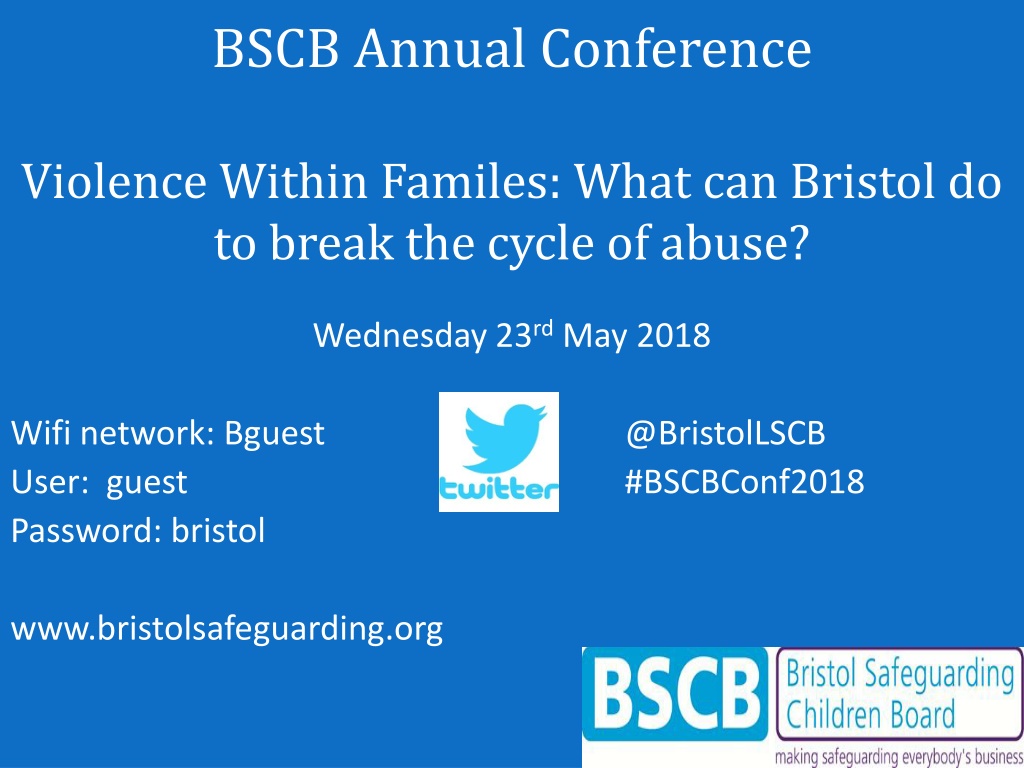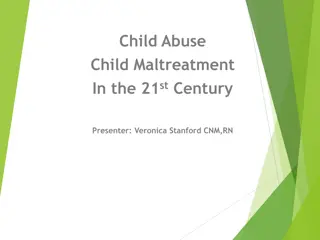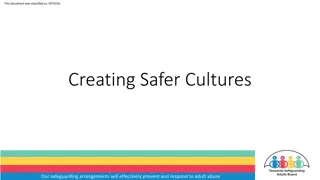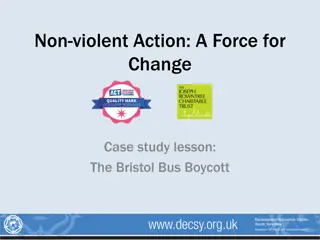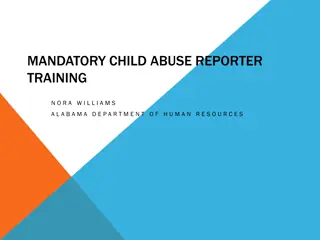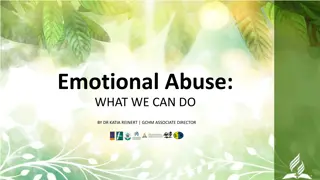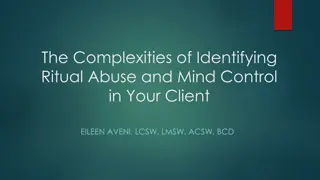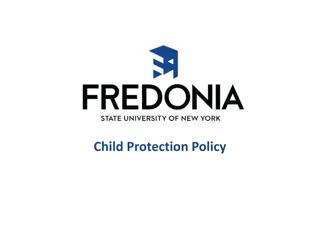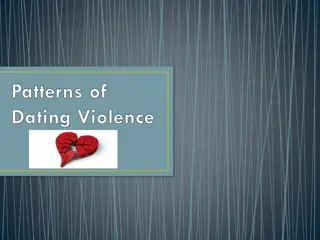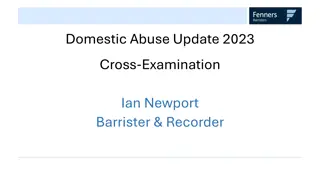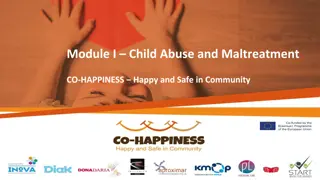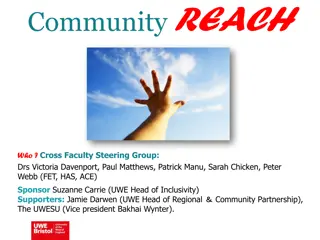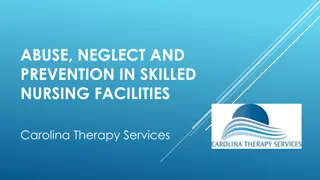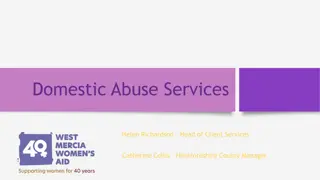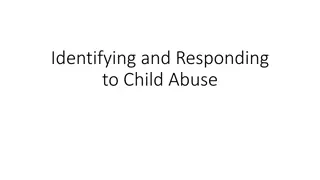Breaking the Cycle of Abuse in Bristol: A Call to Action
The BSCB Annual Conference in Bristol highlighted the urgent need to address violence within families and break the cycle of abuse. The event showcased insights and responses to prevalent forms of abuse like post-separation stalking and teen-to-parent abuse. By adopting a whole family approach and learning from practice, research, and guidance, Bristol can take proactive steps to protect vulnerable individuals from the devastating impacts of abuse.
Download Presentation

Please find below an Image/Link to download the presentation.
The content on the website is provided AS IS for your information and personal use only. It may not be sold, licensed, or shared on other websites without obtaining consent from the author. Download presentation by click this link. If you encounter any issues during the download, it is possible that the publisher has removed the file from their server.
E N D
Presentation Transcript
BSCB Annual Conference Violence Within Familes: What can Bristol do to break the cycle of abuse? Wednesday 23rdMay 2018 Image result for twitter Wifi network: Bguest User: guest Password: bristol @BristolLSCB #BSCBConf2018 www.bristolsafeguarding.org
BSCB Annual Conference Sally Lewis Independent Chair of Bristol LSCB
Whole Family Approaches to Intra Familial Abuse Cherryl Henry-Leach
In the following Case Study, please identify any forms of abuse and the responses to them
Case Study Jane has 2 has 2 children, Rory aged 13 and Saffron aged 6. She separated from Joe 2.5 month ago. Rory is a big boy for his age, and Jane often feels intimidated by him, as he will kick off at her and did so yesterday afternoon. Saffron has phone contact with Joe. Yesterday evening Saffron told Jane Joe liked the green shorts she was wearing when cutting the grass. Today Jane is wanting advice and looks really anxious
Background to Case Study Was a live case that has been anonymised Two forms of abuse are prevalent - Post Separation Stalking - Teen to Parent abuse Both forms of abuse require particular responses which we look at today Learning from practice, research and guidance
Stalking Can occur in the context of domestic abuse Is likely to be a feature of post separation abuse if controlling behaviour was a feature of the relationship Can also be prevalent as cyberstalking 1 in 2 domestic stalkers will act on threats they make In 94% of domestic homicides, stalking was a feature prior to the fatality
Why a Whole Family Approach? 1 in 4 stalkers target CYP, 1 in 3 family/friends On average, 21 people are directly impacted in each case potential witnesses Having CYP in common with a stalker increases likelihood of interaction, difficulties in changing routines and harassment through court of child protective services CYP, family and new partners are vulnerable to stalking by proaxy if not actual stalking
Emerging Themes From Reviews Professionals don t always see stalking as a course of conduct based on patterns Dangerous/inappropriate advice/practice Lack of knowledge about anti stalking legislation Inappropriate use of PINs The civil court system can be used by a stalker as tool Belief that no prior violence = no risk of harm
Stalking is Pattern of unwanted, persistent, fixated and obsessive behaviour that is intrusive and causes the victim fear of violence, serious alarm or distress No legal or statutory definition of stalking beyond aggravated harassment able to reflect bespoke patterns of behaviours
Differences Stalking and Harassment Harassment Stalking Aggravated harassment, that causes alarm, distress and fear of violence Being followed persistently Repeatedly turning up uninvited or loitering Monitoring someone s activity (e.g. social media) Identity theft Watching or spying Interfering with property Unwanted contact causing alarm or distress, can include: Bullying Antisocial behaviour Cyber bullying Sending abusive texts Sending unwanted gifts If the pattern indicates fixation and/or obsession then consider it as stalking
Coercive Control or Stalking Pursuing stalking convictions may not be suitable for cases where we see on/off relationships (R v Widows 2011) Led, in part, to the development of coercive control legislation which recognises the impact of abusive patterns of behaviour within relationships If there is a separation then stalking can occur in the context of the perpetrator trying to coercively ensure the victim returns to the relationship The two pieces of legislation can dovetail and the offence of coercive control can run alongside other offences We can seek stalking convictions once a relationship ends (post- separation abuse) in addition to a conviction for coercive control that occurred during it
Stalking and Mental Health Stalking is a behaviour not a mental disorder Where mental disorder does play a role in stalking, the symptoms/ impact of it will vary, diagnosis, treatment will be complex and take time In a small minority of stalking cases where there behaviour is directly linked to psychosis there can be successful medical treatment the behaviour/risks will still need to be monitored and managed Most stalkers don t suffer from a mental disorder that results in stalking they will present with either fixed beliefs/attitudes, or lack social skills and the stalking is a strategy that replaces socially acceptable behaviour
What does a good response to stalking look like? Encourage reporting to the Police - if reported to the Police then Force area s Crime Report process should be followed and refer CYP for support and assessment Risk Assessment and Management : In the context of DVA DASH should be completed and this includes the S DASH questionnaire If non DVA linked stalking then S DASH questionnaire to be completed Increase safety measures (target hardening) and bespoke safety planning Ensure attempts to reduce the risk are unlikely to heighten it! Support Evidence Building Victim log Safety planning and advice - including potential risk transference Recording and defensible decisions
Advice to victims Report it to the police Complete the Stalking Log/Diary Review personal and online safety for self and CYP Gather evidence safely Trust your instinct Take control lay down boundaries and adhere to them If you have no option but to communicate or have contact with your stalker, try to keep this to an absolute minimum and stay focused on the purpose of contact
Advise victims not to Confront the stalker leave this to the Police Respond to a stalker includes trying to reason or bargain with their stalker Place themselves in situations that could result in heightened risk Blame themselves this includes the if only statements Be complacent about safety Underestimate what the stalker is capable of Use a weapon that can be used against them
Jane Described kicking off as He ll scream and shout at me absolutely awful abuse. It can include him throwing things at me, punching holes in the doors, kicking the walls, threatening to hot me and often Saffron sees this - it doesn t mater if she is in the house or room
What is Teen to Parent Abuse? Defined by Cottrell 2015 as any act of a teenage child that is intended to gain power and control over a parent The abuse can be physical, psychological and/or financial This highlights a dynamic that makes it difficult for us as professionals to identify the abuse and for parents to disclose
Learning from case work It is often a mum experiencing abuse from a son It can, but doesn t always, mirror dynamics in abusive adult relationships Usually, but not always, occurs when the family and/or child are impacted by external stressors or experienced trauma Parents often minimise or struggle to outline the abuse fear of criminalisation of their child
Accessing support Significantly under reported in UK Brighton University suggest 1 in 10 families are imapcted Usually support is accessed when a parent can t manage or cope with the behaviour Parents describe experiencing a revolving door they told us they did not feel as though DVA support suited their needs and that CYP services understood this was not about poor parenting
Support pathways can be difficult, esp if there are other complicating factors within the family YP may not want to disclose their behaviour out of guilt, shame or a lack of understanding about the impact of their behaviour Other children in the family may also feel reluctant to say what is going on if there are other safeguarding concerns being addressed
Development of group work Few examples of successful programmes with even fewer that had been evaluated There was a need to respond to an emerging theme in case work Successful models were based on both the parent and teen undertaking the programme separately but at the same time resource intensive Modelled this approach but also added therapeutic support for other CYP in the families
Programme Content Two sessions a week one for parents and one for YP, aged 11-16 5 in each group Program was underpinned by brief solution focused therapy Explored feelings of anger, blame and isolation Looked at strategies for change assertiveness, boundaries and self care
Some challenges Referral criteria and pathway Ongoing monitoring of the family during group work Training and resourcing Childcare Risk assessment vs behavioural checklist MARAC referrals How we measure success?
What worked with parents? Peer support and challenge which enabled acknowledgement of their feelings and reduced isolation Exploring strategies that redressed the balance and moved them away from responding with mirror behaviour through self reflection and recognising their responses - homework Being supported to separate the behaviour form their child enabled healthier family dynamics Safety planning for themselves and other family members
What worked with YP? Having a safe space to talk through issues and feelings they felt unable to verbalise Talking through their pressures The food Looking at and trying out strategies that enabled them to release pressure more constructively Seeing that they were feeling more like a family
Outcomes after program and 6 mths after Parents reported reduction in abuse, isolation and improved relationships with professionals YP reported feeling more relaxed at home, less violence and increased understanding and empathy Siblings described feeling safer and happier with Saffron saying she was beginning to enjoy her new relationship with her brother ( he s a proper big brother now )
What we learned? Family voice was key to development Earlier intervention meant that sustainable change became more achievable DASH high risk required the need for pre-course work which may require short term placements to enable diffusion and right environment to begin dialogue Professionals initially struggled to respond appropriately IAG, training and development Siblings often don t receive the support they need despite living with volatile dynamics - ACEs Recording and information sharing supports coordination of activity with abuse being seen as a safeguarding issue rather than criminal activity was key to engagement
National Learning Policy guidance needs to be re-visited because: Risk assessment using DASH is not always reflective of the child and parent relationship and the behavioural checklist doesn t reflect he risk posed to the parent Neither reflect impact on siblings and any risk posed to them More programmes are needed!
Breaking Down Barriers Developing An Approach to Include Fathers in Children s Social Care Understanding defensive behaviours in working with fathers Dr Gavin Swann Bristol 2018
A Moment of Reflection Please take two minutes to think about your own father.
Contents The Personal and Professional Context Reflective Considerations Breaking down Barriers Key Messages from the Literature What Social Workers report A Psychodynamic Contribution Findings from a Doctoral Study in LBI How to Include Fathers in Social Work Interventions and Services Conclusions
Principals Transparency Reflection Interaction Practice Group work
Defining Fathers For this lecture fathers are defined as: Any man who has an emotional relationship with a child ; i.e. a biological father, a step-father, mother s partner, or boyfriend or uncle, older brother, grandfather or community leader.
Audience Feedback Why should we include fathers ?
The Personal and Professional Context Reflective Considerations Prejudice, stereotypes, assumptions, years on the front line. The Tavi Experience Year 1: Baby and Mother Observation Year 2: Direct work and the Monroe Effect Year 3: The Research Project Years 4: 6 Doctoral Studies
Our personal assumptions, fears and even prejudices about working with fathers
Breaking down Barriers Researching Children s Social Care A Whole System Approach Systemic assessment A case file audit Literature Review 18 months of Action Research / Co- operative Inquiry ICS A second case file audit
Aims of the Research To design and implement a co-operative inquiry to include fathers in Children s Social Care Develop the skills of co-inquirers Create and adopt a fatherhood strategy with realistic goals and targets Identify objectives for engagement with fathers Refine the existing referral and assessment process Use data collection system/s Ensure that training is available for staff at every level of the organisation/s in father-inclusive practice. Establish better pathways and referral processes Ensure appropriate focused and gender specific information 1. 2. 3. 4. 5. 6. 7. 8. 9.
Basic Measures To increase the numbers of men (fathers, step-fathers, and partners) including telephone numbers, addresses and dates of birth recorded on all referrals. To increase the numbers of men (fathers, step-fathers, and partners) included on Initial assessments. To increase the numbers of fathers comprehensively assessed as part of a core assessment. To increase the numbers of fathers invited to and attending Initial and Review Child Protection Conferences. To increase the numbers of fathers invited to and attending Family Group Conferences. To increase the numbers of fathers invited to LAC reviews. To increase the numbers of fathers involved when initiating court proceedings. To increase the numbers of fathers involved when initiating court proceedings.
International Literature Review & Critique Historic perspectives of the social construction of contemporary masculinity and contemporary fatherhood A shifting social policy towards men Ethnicity, class and the construction of masculinity Men, masculinity and child development Social work in a modern age
Literature Review continued Gender Bias, the Denigration of Fatherhood or Simply Pragmatic Practice? The constructions and pathologies of masculinity in social work An Overview of the Evidence Base; Social Work Practice and the Invisibility of Fathers The Education and Training Social Workers and Research about Men and Masculinity Violence - The construction of men as violence in social work - Domestic violence
Literature Review Continued A Psychodynamic Contribution: Understanding how Violence Influences the Social Work System Defended Organisations Defended Professionals The Role of Supervision in the Inclusion of Fathers in Social Work Interventions How to Include Fathers in Social Work Interventions and Services
Multiple Masculinities Hegemonic Masculinity Subordinated Masculinity Marginalised Masculinity which lead to protest and oppositional masculinity The Impact of masculinities on the engagement of fathers
Fathers & Child Development It is now recognised that, in most cases, child centred and sensitive care giving by both parents through complimentary parenting, (where parents agree role differentiation), contributes to a wide variety of positive child outcomes. (Allen: 2011, Field: 2010, Hauari & Hollingworth: 2009, Lamb and Tamis-Lemonda: 2004).
What Social Workers report Male Responsibility The Personal Fear The Need for Positive Male Role Modelling Organisational responsibility
Male Responsibility A demand for men to take responsibility for the care and protection of their children. Although, this is not a new discourse, it is one that is rarely spoken of in social work
